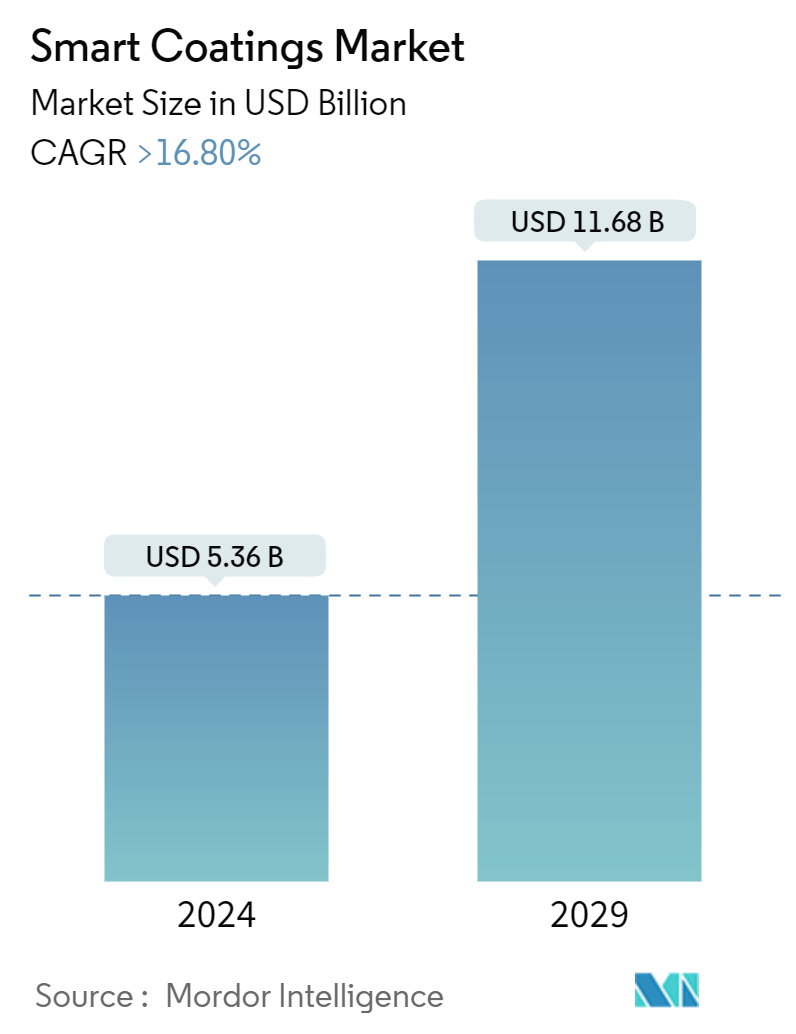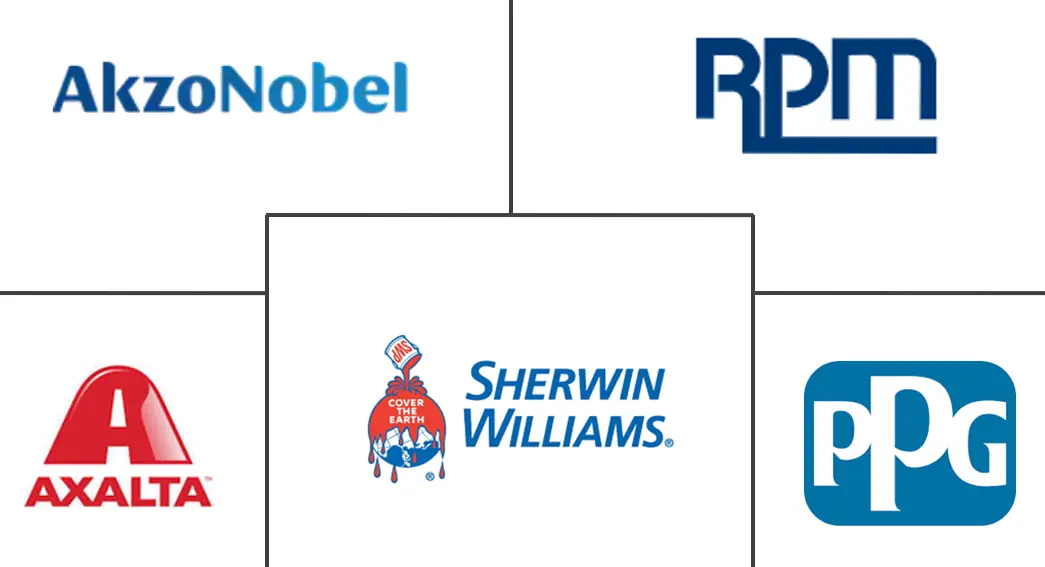Market Size of Smart Coatings Industry

| Study Period | 2019 - 2029 |
| Market Size (2024) | USD 5.36 Billion |
| Market Size (2029) | USD 11.68 Billion |
| CAGR (2024 - 2029) | > 16.80 % |
| Fastest Growing Market | Asia Pacific |
| Largest Market | Asia Pacific |
| Market Concentration | Low |
Major Players
*Disclaimer: Major Players sorted in no particular order |
Smart Coatings Market Analsyis
The Smart Coatings Market size is estimated at USD 5.36 billion in 2024, and is expected to reach USD 11.68 billion by 2029, growing at a CAGR of greater than 16.80% during the forecast period (2024-2029).
The COVID-19 pandemic had a negative impact on the market; however, post-pandemic, the market is projected to grow steadily during the forecast period owing to growth in various end-user industries like construction, automotive, aerospace, and defense worldwide.
- In the short term, superior properties over traditional coatings and rising demand from the construction industry are expected to drive the market.
- On the other hand, the high cost of smart coatings is expected to restrain the market and hinder its growth.
- The increasing use of nanoparticles to improve functionality and opportunities for smart coatings to replace conventional coatings in various end-user industries are projected to create an opportunity for the market in the coming years.
- Asia-Pacific is expected to dominate the market and witness the highest growth rate during the forecast period.
Smart Coatings Industry Segmentation
The smart coating is a functional coating with one or more properties that can be changed significantly in a controlled fashion by external stimuli. This coating category can sense and respond to a stimulus in its environment (pressure, light, heat, etc.) and react predictably and reversibly.
The smart coatings market is segmented by function, end-user industry, and geography. By function, the market is segmented into anti-corrosion, antifouling, anti-microbial, anti-icing, self-cleaning, color-shifting, and other functions. By end-user industry, the market is segmented into building and construction, automotive and transportation, marine, aerospace and defense, and other end-user industries. The report also covers the market size and forecasts for the smart coatings market in 13 countries across major regions. For each segment, the market sizing and forecasts are done based on revenue (USD).
| Function | |
| Anti-fouling | |
| Anti-microbial | |
| Anti-corrosion | |
| Anti-icing | |
| Self-cleaning | |
| Color-shifting | |
| Other Functions |
| End-user Industry | |
| Building and Construction | |
| Automotive | |
| Marine | |
| Aerospace and Defense | |
| Other End-user Industries |
| Geography | |||||||
| |||||||
| |||||||
| |||||||
|
Smart Coatings Market Size Summary
The smart coatings market is poised for significant growth over the forecast period, driven by increasing demand from various end-user industries such as construction, automotive, aerospace, and defense. The market, which experienced a downturn due to the COVID-19 pandemic, is expected to recover and expand steadily. The construction industry, particularly in the Asia-Pacific region, is a major contributor to this growth, with smart coatings being utilized for applications like self-cleaning, antimicrobial, and anti-corrosion purposes. Despite the high cost of raw materials posing a challenge, the use of nanoparticles to enhance functionality presents a promising opportunity for market expansion. The Asia-Pacific region is anticipated to lead the market, benefiting from robust construction activities and a burgeoning automotive sector.
The global smart coatings market is semi-consolidated, with key players such as Akzo Nobel NV, PPG Industries Inc, The Sherwin-Williams Company, RPM International Inc., and Axalta Coating Systems, LLC. These companies are actively engaging in strategic acquisitions and collaborations to enhance their market offerings. For instance, The Sherwin-Williams Company expanded its portfolio by acquiring Sika AG's European industrial coatings business, while AkzoNobel invested in Qlayers to advance industrial coating application technology. These strategic moves are expected to bolster the market's growth trajectory, as smart coatings continue to find increasing applications across various industries, particularly in regions with thriving construction and automotive sectors.
Smart Coatings Market Size - Table of Contents
-
1. MARKET DYNAMICS
-
1.1 Drivers
-
1.1.1 Superior Properties Over Traditional Coatings
-
1.1.2 Growing Demand from the Construction Industry
-
-
1.2 Restraints
-
1.2.1 High Cost of Smart Coatings
-
-
1.3 Industry Value Chain Analysis
-
1.4 Porter's Five Forces Analysis
-
1.4.1 Bargaining Power of Suppliers
-
1.4.2 Bargaining Power of Consumers
-
1.4.3 Threat of New Entrants
-
1.4.4 Threat of Substitute Products and Services
-
1.4.5 Degree of Competition
-
-
-
2. MARKET SEGMENTATION (Market Size In Revenue)
-
2.1 Function
-
2.1.1 Anti-fouling
-
2.1.2 Anti-microbial
-
2.1.3 Anti-corrosion
-
2.1.4 Anti-icing
-
2.1.5 Self-cleaning
-
2.1.6 Color-shifting
-
2.1.7 Other Functions
-
-
2.2 End-user Industry
-
2.2.1 Building and Construction
-
2.2.2 Automotive
-
2.2.3 Marine
-
2.2.4 Aerospace and Defense
-
2.2.5 Other End-user Industries
-
-
2.3 Geography
-
2.3.1 Asia-Pacific
-
2.3.1.1 China
-
2.3.1.2 India
-
2.3.1.3 Japan
-
2.3.1.4 South Korea
-
2.3.1.5 Rest of Asia-Pacific
-
-
2.3.2 North America
-
2.3.2.1 United States
-
2.3.2.2 Canada
-
2.3.2.3 Mexico
-
-
2.3.3 Europe
-
2.3.3.1 Germany
-
2.3.3.2 United Kingdom
-
2.3.3.3 Italy
-
2.3.3.4 France
-
2.3.3.5 Rest of Europe
-
-
2.3.4 Rest of the World
-
2.3.4.1 South America
-
2.3.4.2 Middle East and Africa
-
-
-
Smart Coatings Market Size FAQs
How big is the Smart Coatings Market?
The Smart Coatings Market size is expected to reach USD 5.36 billion in 2024 and grow at a CAGR of greater than 16.80% to reach USD 11.68 billion by 2029.
What is the current Smart Coatings Market size?
In 2024, the Smart Coatings Market size is expected to reach USD 5.36 billion.

